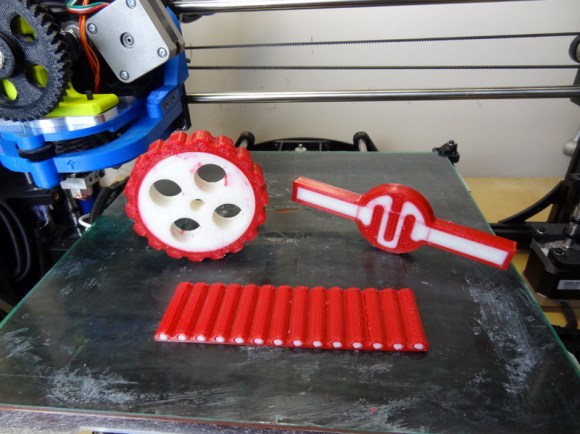
Ever heard of the FlexyDualie extruder? It’s a new opensource dual extruder from Aleph Objects (makers of the Lulzbot and TAZ), specifically designed for printing in a hard material — and a flexible one!
[James Bruton] of XRobots just got his hands on one and a new TAZ printer, and he’s shared his thoughts. He’s using ABS plastic and Ninjaflex rubber filament to test it out. Sure you can sometimes print with Ninjaflex using a regular extruder… but get ready for headaches as it jams in your extruder guide. The FlexyDualie is specifically designed for extruding flexible filaments which results in a lot less headaches, and a lot more productivity!
In the following demonstration video, [James] shows us the awesome possibilities of printing parts in both a hard and soft material. He even goes into detail on how to setup Slic3r for multi-material STL files.
From rubber wheels with hard rims, to uni-directional flexible joints, or even tank treads for a robot… The possibilities are staggering. In fact, he’s planning on making an entire Alien costume 3D printed!
















printing in “rubber” most awesome. Love that lulzbot. I sold my Gigabot and am looking for something a bit smaller, but dual print head. This might just fit the bill.
What sort of chemical resistance does Ninjaflex have? I’m thinking O-rings, which aren’t O-shaped.
There are a bunch of TPEs (Thermoplastic elastomer) on the market that are used in injection, extrusion, compression molding. I am not sure which one NinjaFlex is, here is info from their FAQs (you would need to get an MSDS from them to determine the chemical makeup to determine which actual TPE blend/class they are using to extrude their filament from):
*While NinjaFlex is resistant to most oils, it is highly affected by solvents, acids, and fuels such as gasoline. If the printed part should need to be cleaned, a mild soap solution is recommended.
*While occasional contact with water will have no adverse effect on NinjaFlex, the product will degrade and lose its elastic properties when submerged in water for extended periods of time.
*The recommended maximum temperature for NinjaFlex printed parts is 150°F.
*The recommended minimum temperature for NinjaFlex printed parts is -22°F. Below this temperature, printed parts will become increasingly brittle and may shatter.
anyone got the STLs to print one? i saw that URL and i do not know how to open those files, nor which parts i have to print
Seconded, that directory is a hot mess, anyone have any luck building this extruder setup?